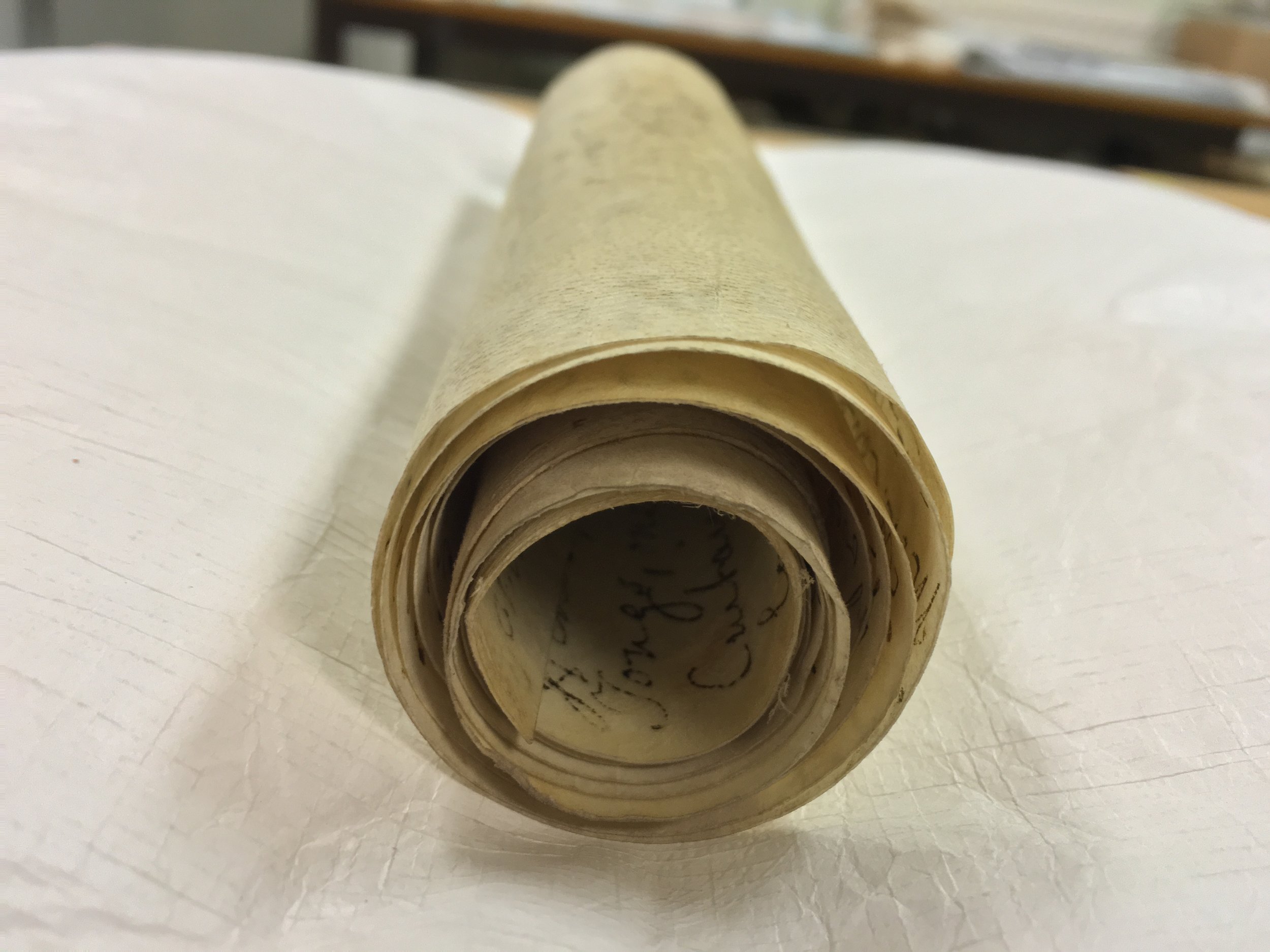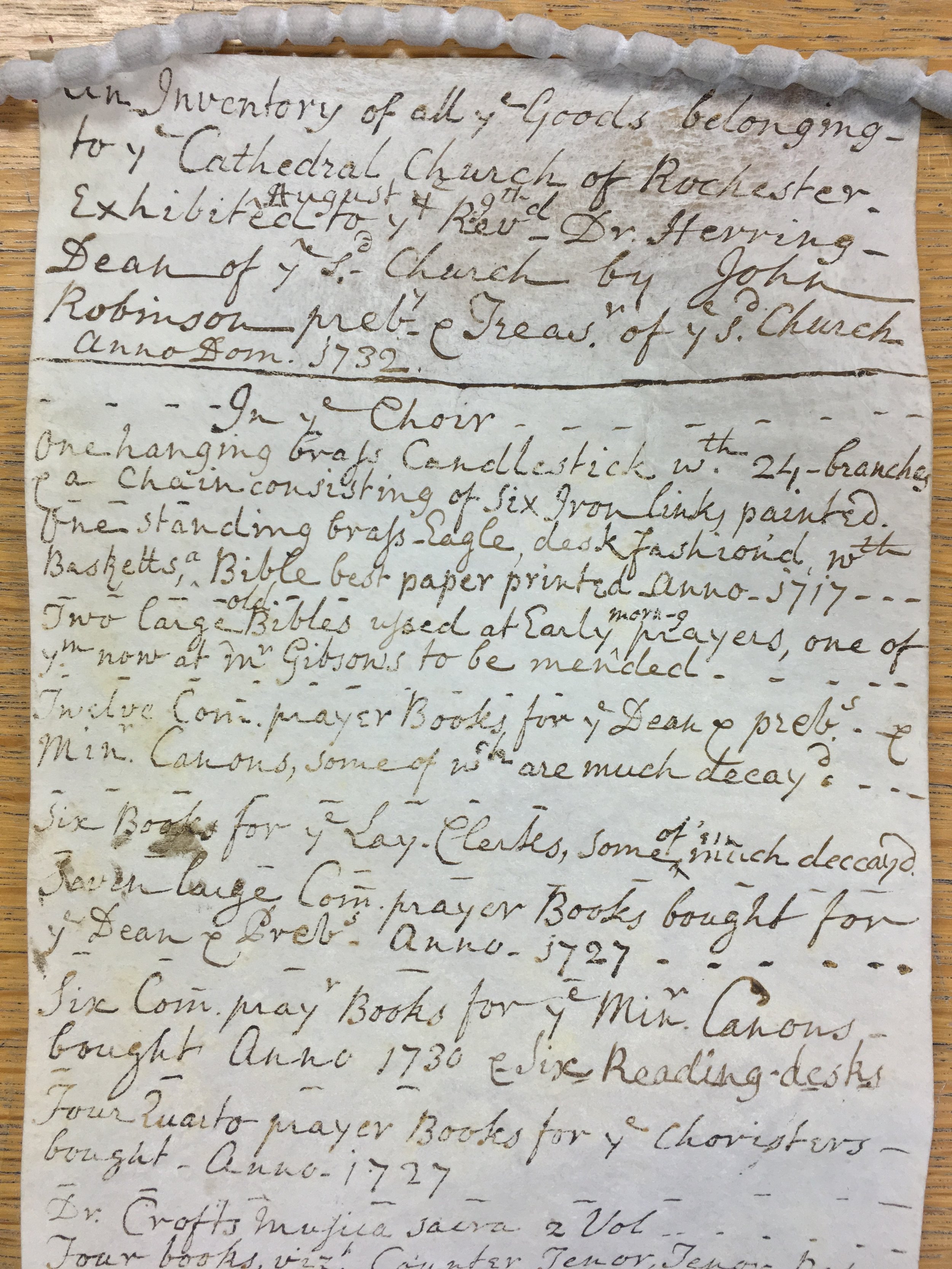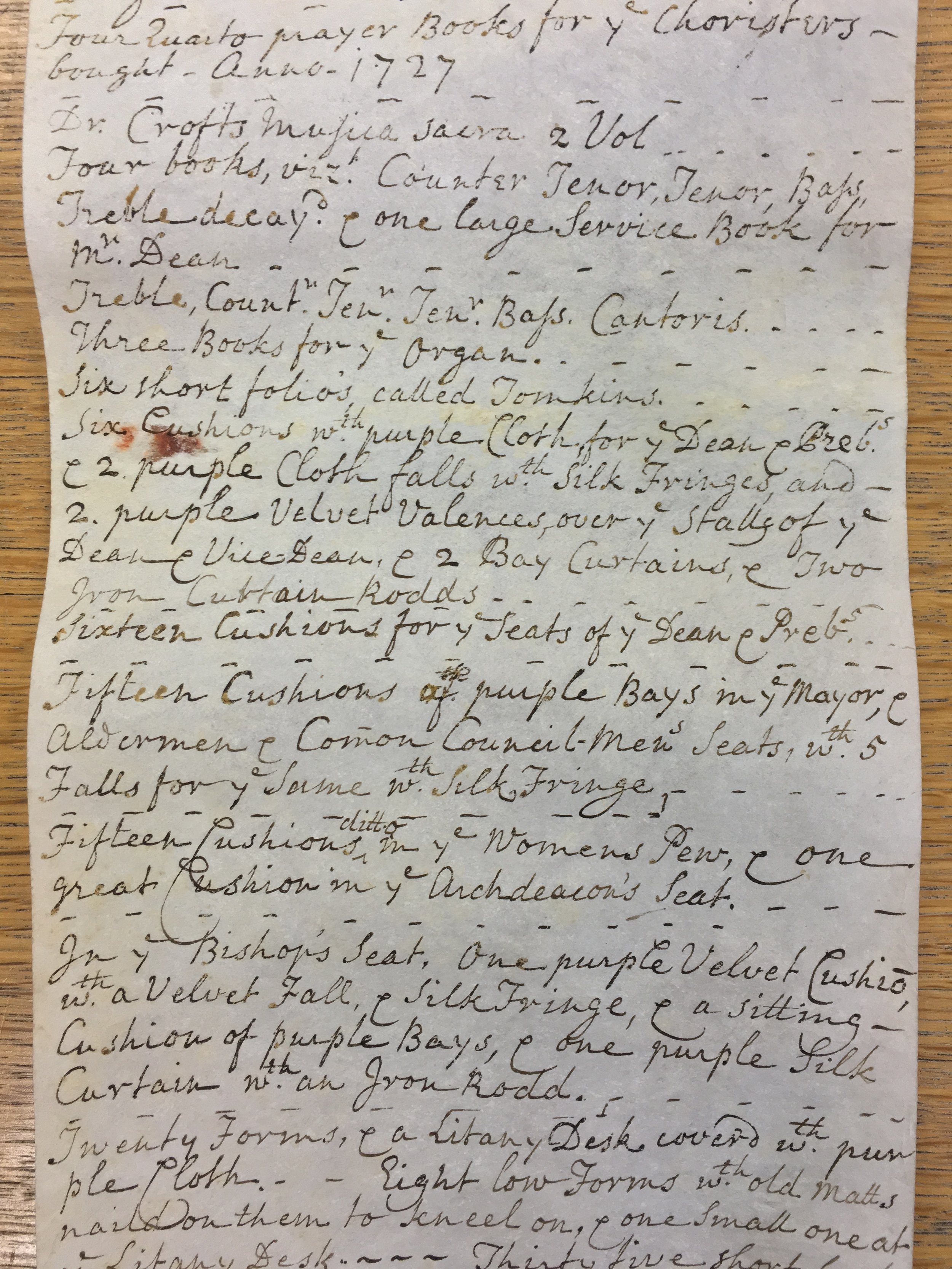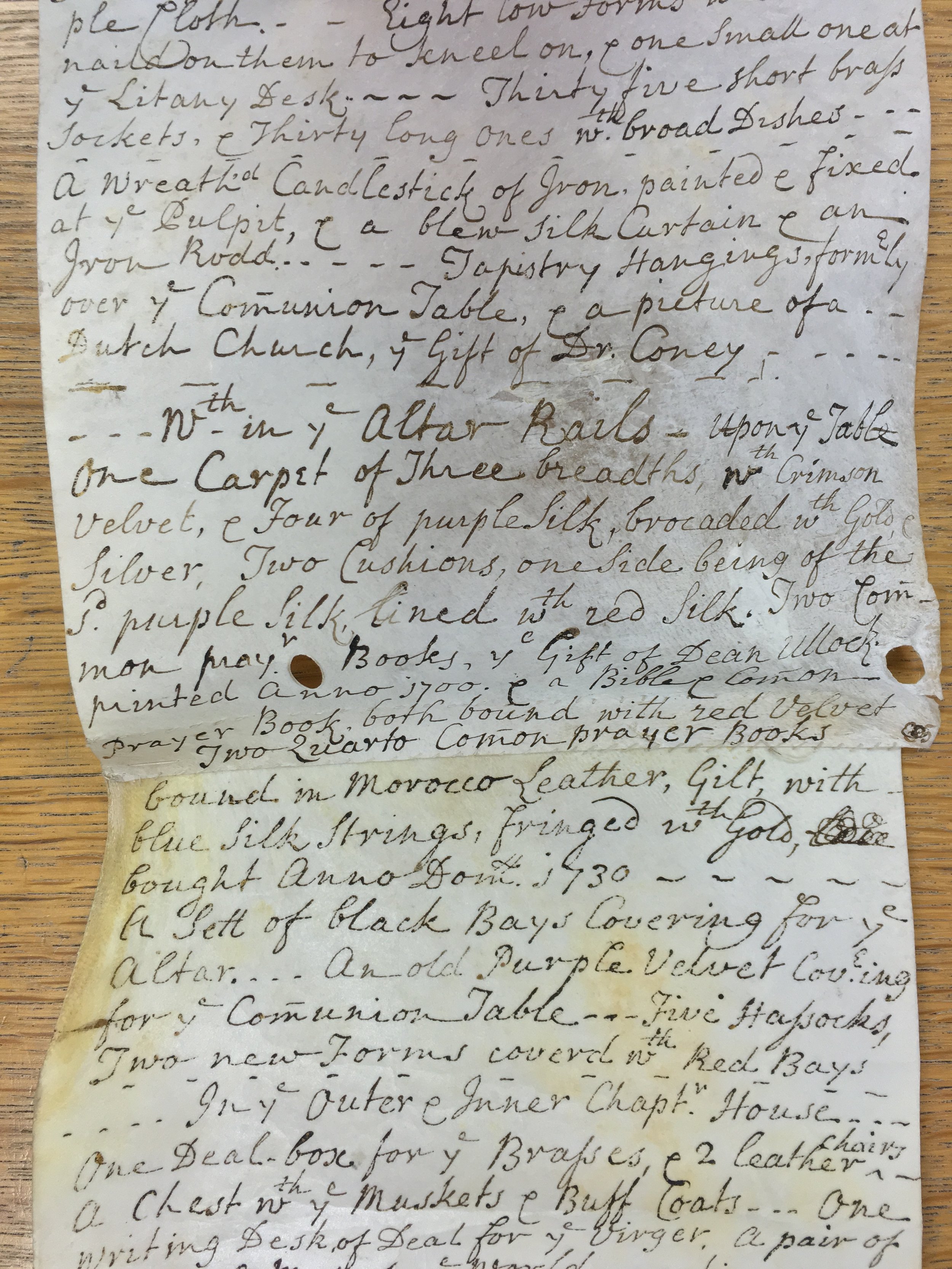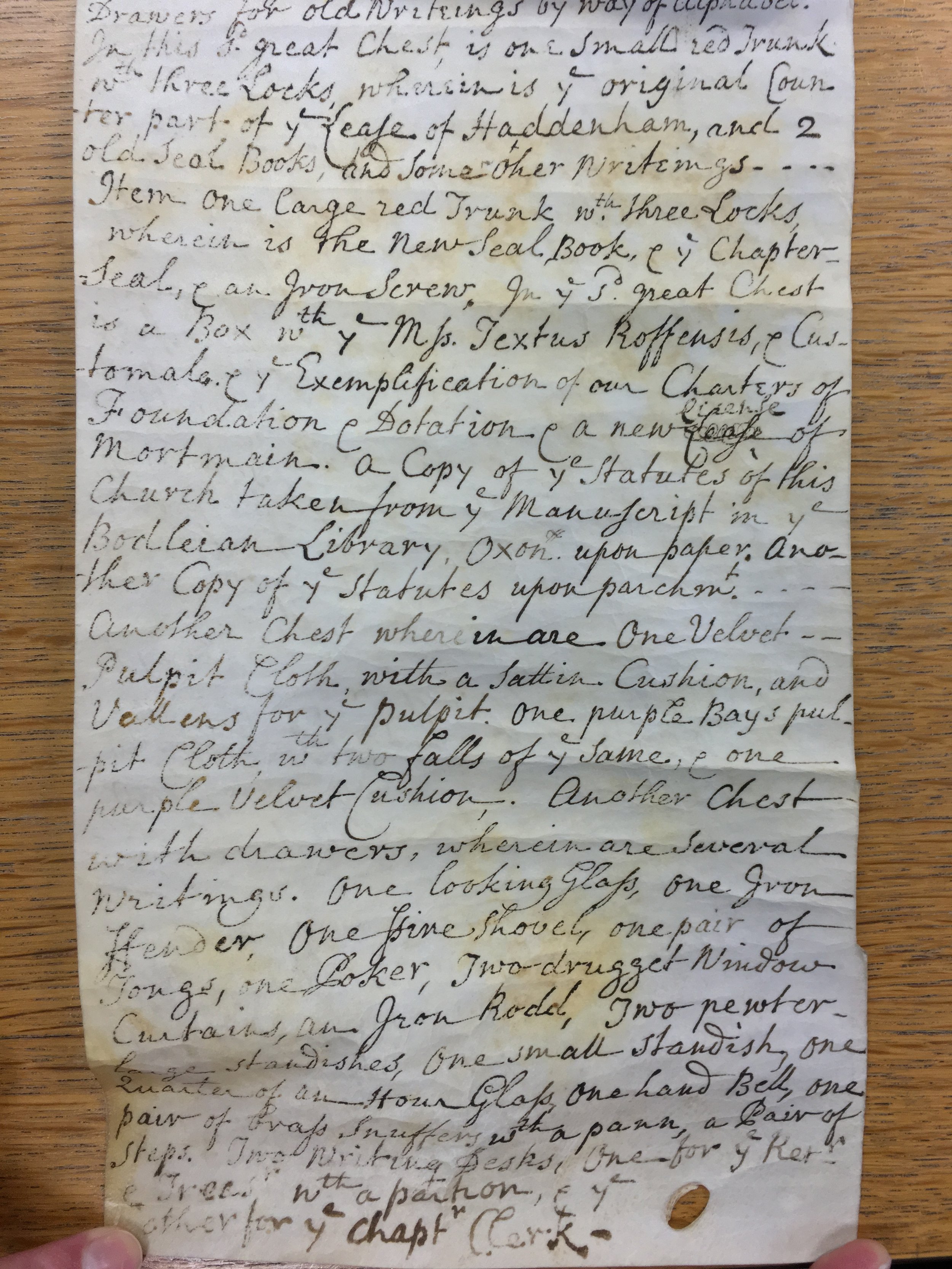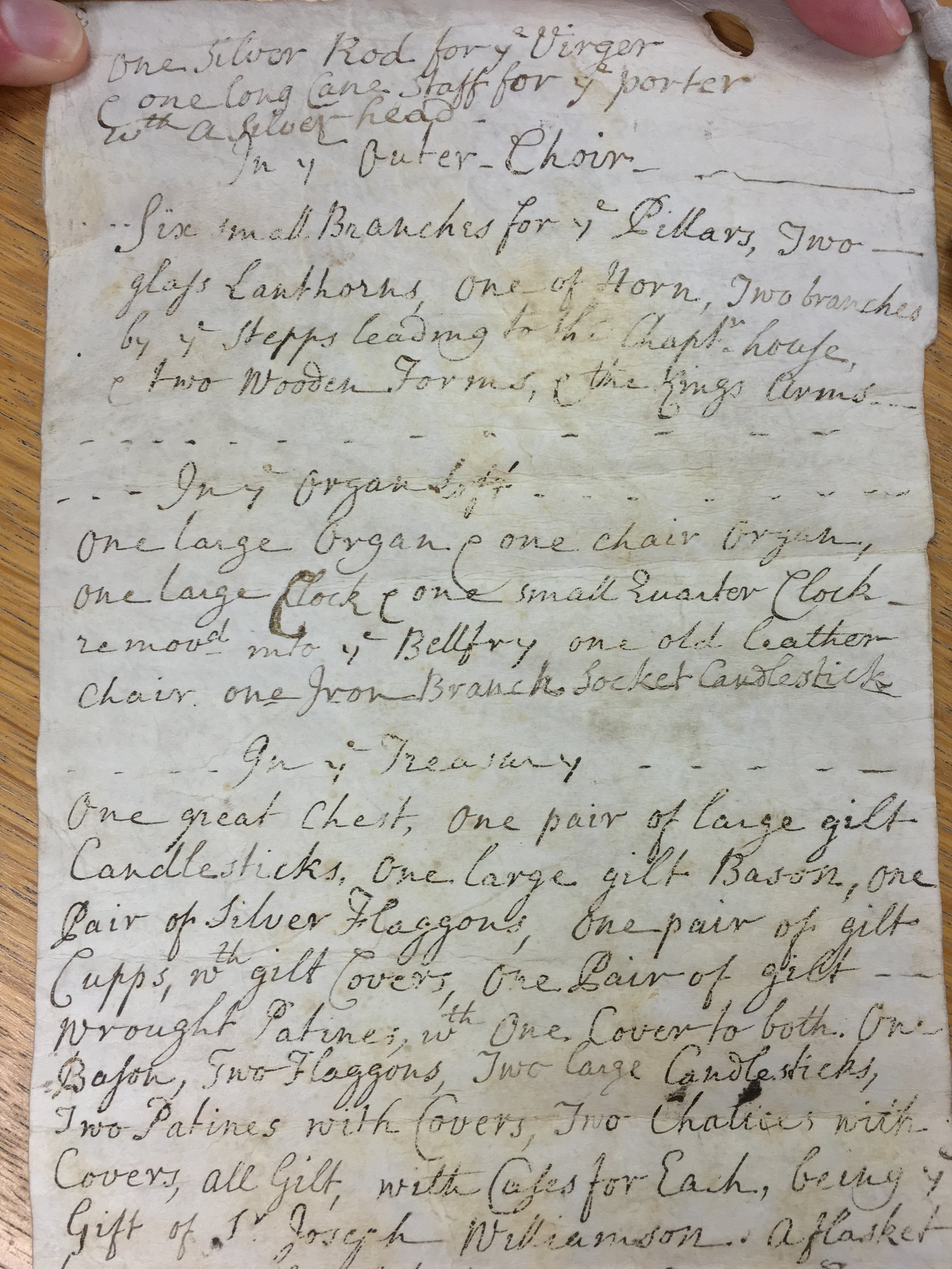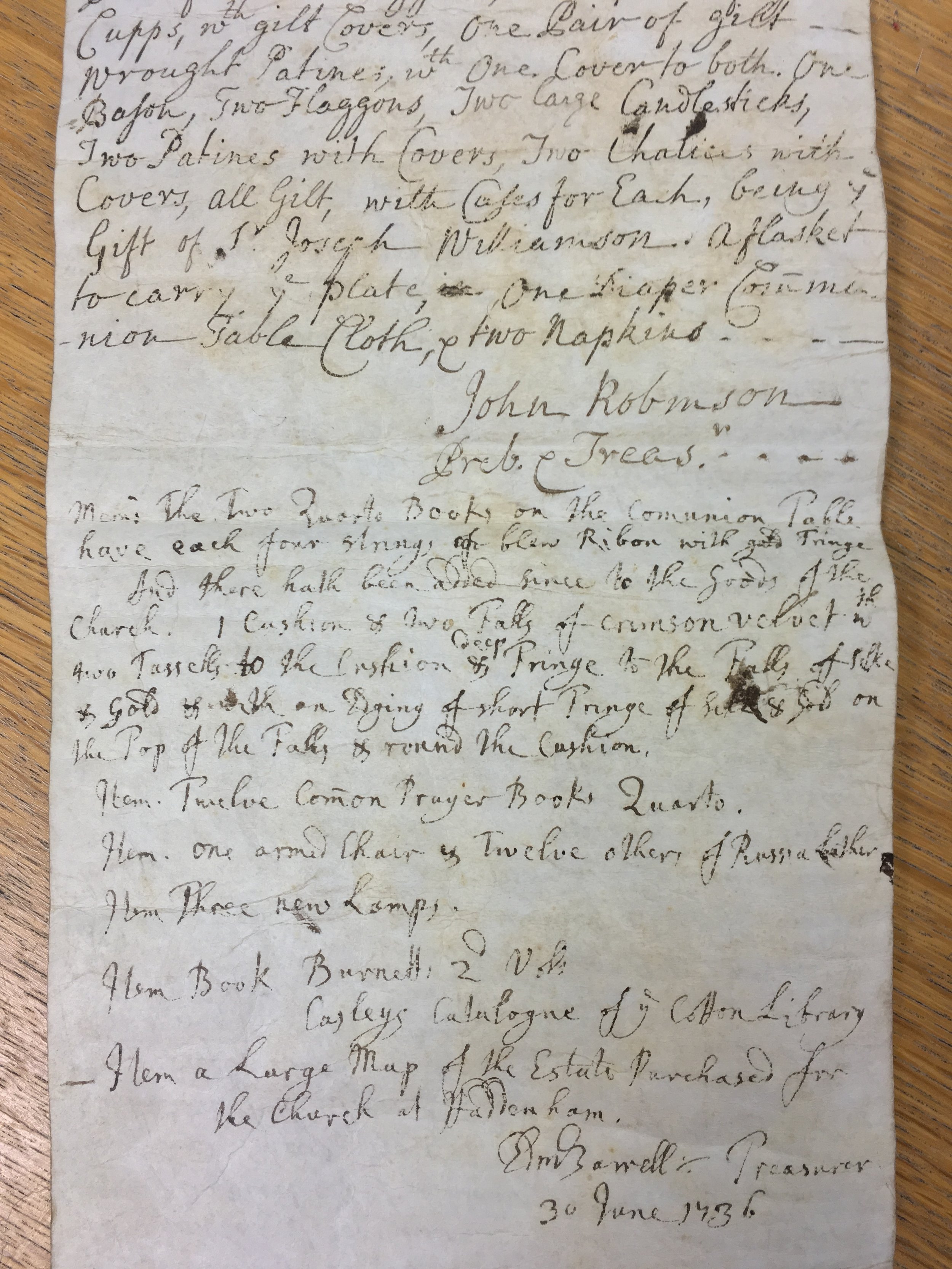Cathedral inventories
/Carolyn Foreman investigates the historic inventories of the Dean & Chapter. Featured in The Friends of Rochester Cathedral Annual Report for 1998-1999.
The 1990 Care of Cathedrals Measure required all English Cathedrals to compile an inventory of objects in the possession of the Chapter which were considered to be of 'architectural, archaeological, artistic or historic interest.¹ Rather surprisingly, in contrast to parishes, Chapters had not previously been obliged to maintain inventories. The advantages of a national record in terms of conservation, care, security and research were obvious and perhaps one or two high profile disputes about the disposal of objects in Cathedrals had also had an influence. Very detailed guidelines' about the content of an inventory made it clear that 'objects' included not just obvious items such as furnishings, vestments and plate but glass, monuments and even doors and tiles. The challenge then was to set about making lists and descriptions of objects with a minimum of bureaucracy and (at the Comptroller's insistence!) even less expense. At this point Canon Armson asked me, as an interested amateur, to compile an initial draft and find out what I could about the history of individual objects under the guidance of an Inventory Committee set up by the Fabric Advisory Committee.
Read more about the work of the Fabric Advisory Committee:
Fabric Advisory Committee
Julian Limentani, Chairman of the Fabric Advisory Committee reports on its establishment and first decade of work.
Read more
The first task was to make a general list of all the objects belonging to the Cathedral. A detailed inventory compiled in 1985 and including everything from altars and copes to fire extinguishers and vacuum cleaners proved an invaluable basis for this exhaustive, and exhausting, task. Chairs in a Cathedral are like sheep in a field - they simply will not stand still to be counted. The next obvious step was to consult the written records, in particular the Dean and Chapter's archives.² These contain a wealth of information about the Cathedral's history and fabric but with some very frustrating gaps.
It soon became clear that there are only a few objects in the Cathedral which have been there since before the Commonwealth - most notably some medieval monuments,³ the 13th century painted wood in the choir stalls and the 'vestry'⁴ and the very early door in the north quire transept.⁵ In the 1640s, although the Cathedral did not suffer as badly as some, it apparently lost glass, images, books, furnishings and metalwork from monuments,⁶ this on top of destruction at the Reformation a century earlier.
Things took a turn for the better from the 1660s. A succession of inventories in the Archives, dating from c 1672 until about 1743⁷ show a steady accumulation of objects and give an interesting glimpse of the priorities of the time. In about 1672 the property included two organs, an 'Eagle', a pulpit, a litany desk and prayer books, none of which survive. Cushions and hangings feature in abundance. Everyone who was anyone had a purple cushion, with subtle differences to denote status. The cushions of the Common Counsell men sported little vallances with fringe' but the Counsell men's wives had to make do without the vallances. By about 1678, attention had turned to the Chapter House which had acquired, amongst other things, a leather carpet and a 'velvet purple chair with armes for Deane', with seven printed leather chairs and four plain.
Photographic copy of the 1732 inventory in Medway Archives.
Apart from books (which were outside my remit), very few objects from these early inventories can be identified with any certainty. The 'payre of wrought guilt pattons with 1 cover to them' must surely be the Rochester Tazze, acquired from the Dean and Chapter by the British Museum in 1971. These early sixteenth century cups are assumed to have been given to the Cathedral after the Reformation to replace chalices which had been melted down. Also in the very short list of plate are '1 payre of Guilt Cupps' and '2 Guilt covers'. These are presumably the Cooke Cups, given by Prebendary Cooke and still in the Cathedral. These elegant cups with trumpet shaped feet and shallow covers are hallmarked 1662, the year in which Dr Cooke was granted the arms which are engraved on the sides. Can any inference be drawn?
From the end of the 1680s onwards The Cooke cups, 1661. Photo: H. Teed are listed the buff coats and other items which formed the equipment of the Cathedral's band of militia men.⁸ The remnants can be seen in the Guildhall Museum, where they are held on loan from the Dean and Chapter, as can the Williamson plate. A special addition to the inventory in 1701 records what must at the time have been an outstanding acquisition. The plate is one of the few sets surviving from the Commonwealth period, hallmarked 1653 and made by the maker whose mark was the hound sejant for the private chapel of James 4th Duke of Lennox at Cobham Hall. The set was subsequently acquired by Sir Joseph Williamson, a local man made very good and well known for his benefactions in Rochester, and left to the Cathedral in his will.
A little more information comes from the many invoices and payment records preserved from the late 17th and 18th centuries. The inventory of about 1678 mentions the King's Arms. On 26 January 1674 Mr Vittles, smith, was paid for 'four great hooks to affix the coate of Armes going into the Quire.’⁹ If these are the same arms of Charles II which now hang, much over-painted, in the south quire aisle, they have led a peripatetic existence. In 1733 J. Proby, plumber, was paid £1.15s for cleaning and new painting the Kings Armes and the 'Masons and Carpenters' received 2s 4d 'for a reward of care in putting up ye King's Arms.’¹⁰ By 1825 the Arms had been fixed over the Great West Door and at that time were moved yet again to be set up against the organ gateway.¹¹ Another invoice is dated 5 August 1735.¹² R. Say submitted his bill for '12 large and strong Walnutree Chair stufft in ye seat with curld hair and covered with Leather nailed with Brass Nails 15s 6d each', together with an arm chair and the 18th century equivalent of a Carriage charge 'matts, cord, packing and wharfage'. Some of these chairs were until recently in the Chapter Room. In general though most of the items recorded in these early bills (lots more purple cushions and hangings!) have long since disappeared.
Many of the objects most familiar to worshippers in the Cathedral date from the 19th century, amongst them the nave pulpit of Cottingham from 1840, the Bishop's Throne, pulpit, reredos and organ case designed by Scott in the 18705 and the altar rails and Great West Door from Pearson around 1890. It might be expected that the Archives would preserve a great deal of information about objects acquired so comparatively recently but this is not so. If any inventories were kept between 1743 and the 1920s they do not survive. The Bishop in his Visitation in 1889 'called attention to the desirability of having an inventory of all the articles, goods and movables in the Church'. The Chapter minutes¹³ record that the Sacrist and Verger were to draw one up. Did they carry out the Chapter's instructions?
Often there is only a passing comment about an object. The Minutes of 25 September 1868¹⁴ mention the gift of a brass lectern from Bishop Claughton. The brass Eagle lectern still in use today can be seen clearly in a picture of 1870¹⁵ so we can assume it has been in the Cathedral since 1868, but that is all we know. The glass presents perhaps the most frustrating case. Apart from some fragments in the Crypt which have been collected from elsewhere, all the glass was installed between 1859 (the memorial windows to Archdeacon King in the north nave transept, by Clayton and Bell) and 1929 (in the north quire transept in memory of General Maxwell, Forsyth & Grylls).¹⁶ The archives tell us almost nothing. Scraps of information comes from unlikely sources such as a programme for the unveiling in 1883 of glass given by the Royal Engineers which identifies the maker as Clavton and Bell. An advertisement in a 19305 guidebook states that Powell made two of the windows in the north nave aisle and two in the south quire aisle. So many of the objects were private donations and apart from granting approval for installation, the Chapter seem to have been content to leave the arrangements to the donors. Fortunately Mr Palmer compiled a very detailed guidebook, first published in 1897,¹⁷ and this is the source of much (and sometimes the only) information about objects from the preceding thirty years.
For a few objects on the other hand there is plenty of detail. The archives preserve Pearson's bill for the altar rail given in memory of Dean Scott and still in situ.¹⁸ This includes White and Sons of Oxford Street's invoice of April 25 1889 for 'making 2 9ft lengths hand wrought brass ornamental scrolled polished Altar Rain 1889 for 'making 2 9ft lengths hand wrought brass ornamental scrolled polished Altar Rails fitted with Gun Metal Sockets for fixing: Cutting holes in stone step and fixing'. The papers of J.T. Irvine, Scott's Clerk of Works, also contain much fascinating material. Hanging in the south quire transept is a section of 13th century painted wood, framed and glazed. Irvine explains exactly how it came to be there, together with an insight into the attitude of the Chapter in the days before Fabric Advisory Committees. When work started on repainting the familiar 14th century leopard design in the quire in the 18705, the very early back to the Prior's stall remained with its original red and green painted diamond pattern. Irvine records 'I was very loth to move this but the Chapter wanted it done away with. For some months, with Sir G G Scott's support, who wanted it preserved, I was able to avoid carrying out the Chapter's orders but eventually the Chapter conquered for after a Chapter meeting I received through the Chapter Clerk a formal copy of their minute in writing ordering it at once to be removed. I was obliged of course to send it to Sir Gilbert and execute the destruction. Sir G G Scott recommended cutting out the whole piece and preserving it under glass and inserting a new slab of wood. This was done and the frame and glass was provided and given by Mr Charles Foord Builder, the Chapter's surveyor out of his love for the Cathedral'¹⁹
The twentieth century has seen many more additions to the Cathedral's property - donations, such as the screen in the Lady Chapel in memory of Dean Storrs, the magnificent funeral pall given by Lord Northbourne²⁰ and several silver items the work of Omar Ramsden - and commissions by the Chapter, among them the new furnishings for the Lady Chapel and the glass and wrought iron screen to the Ithamar Chapel. One very important acquisition was the 13th century bronze crozier head given by a friend in 1912 to Bishop Harmer who in turn presented it to the Cathedral. The volute is engraved with floral and geometric patterns and encloses figures of Mary and the Angel of the Annunciation. The crozier is still in use today. It was found in the thatched roof of a cottage at Allingham, leading to speculation that it might have been held by the last Abbot of Boxley. Another item of great interest but unknown origin is a 15th century red damask dalmatic with applique panels of wool and gold thread. The material is much worn and faded but figures of saints can still be made out, including St Stephen in his deacon's vestment. Does anvone know where this came from? It is mentioned in a guidebook compiled by Dean Underhill in the 1930s but I cannot find any earlier reference.
Now that the initial list is complete, the Fabric Advisory Committee have to decide where the 'threshold of interest lies, in other words which objects should be included in the deposited version of the inventory. This will not be easy. Whilst there are plenty of obvious candidates for inclusion, what about, say, twentieth century articles which have been purchased from ecclesiastical furnishers and not individually designed? They may not in their own right be of great artistic interest but a future researcher may want to know about the overall practice of furnishing Cathedrals in the late 20th century. Fortunately that's not my decision!
Carolyn Foreman
Inventory articles
Several articles on the research blog are reproduced from the inventory compiled by Carolyn Foreman:
Footnotes
1 Directions issued by the Cathedrals Fabric Commission for England, pursuant to the Care of Cathedrals Rules (1990), Rule 17
2 The archives of the Dean and Chapter are deposited in the Medway Studies Centre at Strood Library, with the prefix DRc
3 An inventory of all the monuments in the Cathedral, compiled by Dr John Physick, is deposited in the Cathedral Library, ref RC 733.2 PHY
4 Friends of Rochester Cathedral Report 1994/95 pp10-23 Article by Charles Tracy and Cecil Hewett
5 Friends of Rochester Cathedral Report 1989/90 pp19-22 Article by Jane Geddes
6 Faith and Fabric: A History of Rochester Cathedral ed Yates and Welsby, Boydell, 1996 pp77, 185-6
7 ibid DRc/EIf1 - Elf 9/2
8 Friends of Rochester Cathedral Report 1986 pp12-13. Article by Michael Moad
9 ibid DR/FTb/10
10 ibid DRc/FTv/77 and FTb/68
11 ibid DRc/Emf135
12 ibid DRc/FTv/79
13 ibid DRc/Ac15, 12 Nov 1889
14 ibid DRc/Ac14
15 Photograph in the National Monuments Record, reproduced as Plate 11 in Faith Fabric, op. cit.
16 Research by Mrs Anneliese Arnold into the history of the glass is deposited in the Cathedral
Library, ref RC 733.6 ARN
17 G.H. Palmer, The Cathedral Church of Rochester (Bells Cathedral Series), 1897
18 ibid DRc/Emf/64/1
19 ibid DRc/Emf77/73
20 Friends of Rochester Cathedral Report for 1990/91, p4. Article by Molly G. Proctor
Featured in The Friends of Rochester Cathedral Annual Report 1989-1999.
Friends of Rochester Cathedral Annual Reports
The Friends of Rochester Cathedral were founded to help finance the maintenance of the fabric and grounds. The Friends’ annual reports have become a trove of articles on the fabric and history of the cathedral.
The Friends of Rochester Cathedral were founded to help finance the maintenance of the fabric and grounds. The Friends’ annual reports have become a trove of articles on the fabric and history of the cathedral.
The Cathedral is full of features and furnishings for the purpose of worshipping God, singing His praise, administering the sacraments and spreading The Word of Christ.


